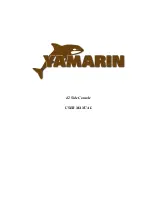
3-29
O
PERATION
3
traiLErinG
avoid accident and injury from
improper trailering:
• The trailer must be matched for
the boat’s weight and hull.
• The towing vehicle must have
the capacity of pulling the load.
pulling a load that exceeds the
towing capacity may cause loss
of control.
• Be sure the boat is secured to
the trailer and the trailer is prop-
erly hitched to the towing vehicle
before towing.
• Read the manuals supplied with
the trailer by the manufacturer.
A trailer is provided as standard equip-
ment with your boat. If you need to
obtain another trailer, choose one that
is manufactured to carry a boat of the
size and weight of your boat. Check
the certification label on the left for-
ward side of the trailer. This label is
required to show the Gross Vehicle
Weight Rating (GVWR), which is the
load carrying capacity of the trailer plus
the trailer’s weight. Be sure that the
total weight of your boat, any cargo,
and the trailer weight itself does not
exceed the GVWR.
hitCh
The trailer hitch ball must match the
size of the socket on the trailer hitch
coupler. Hitches are divided into class-
es that specify the gross trailer weight
(GTW) and the maximum tongue
weight. Always use a hitch rated for the
same or higher class. Use a bolted-on
or welded-on hitch; clamp-on bum-
per hitches are not recommended. Be
sure the trailer hitch’s release handle
is latched with the lock pin installed
before towing.
Use safety chains between the tow-
ing vehicle and the trailer so the trailer
will not detach completely from the
towing vehicle if it accidentally comes
loose from the hitch ball. Crisscross
the chains under the trailer tongue so
the tongue will not hit the road surface
if it falls loose. Rig the chains as tightly
as possible while allowing just enough
slack to permit tight turns.
Be sure the tongue weight (vertical
weight on the hitch point) is correct.
Generally, 5% to 10% of the combined
weight of the boat and trailer should
be on the tongue. Too much or too little
weight can cause difficult steering or
trailer swaying.
traiLErinG ChECKLiSt
•
Check your state laws to be sure
your trailer meets all regulations,
such as proper licensing, brake,
axle load, and safety chain require-
ments.
•
Check trailer for any loose fasteners
or damaged parts.
•
Check tires for proper inflation.
WARNING
















































